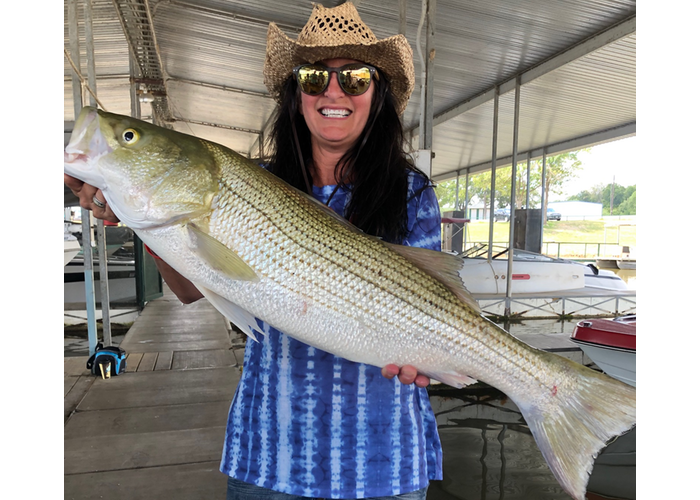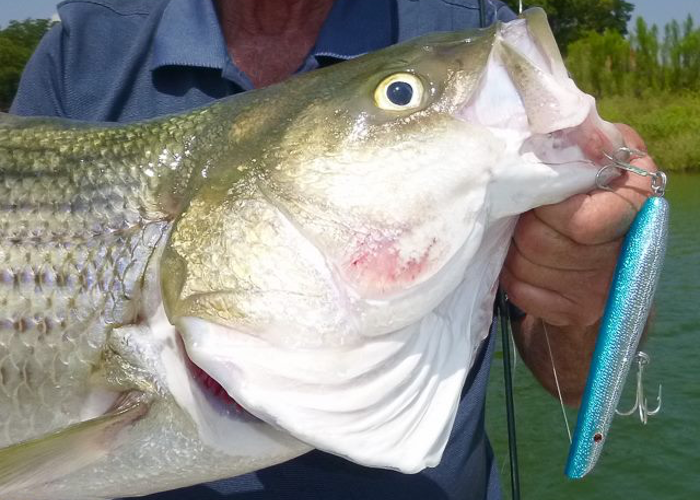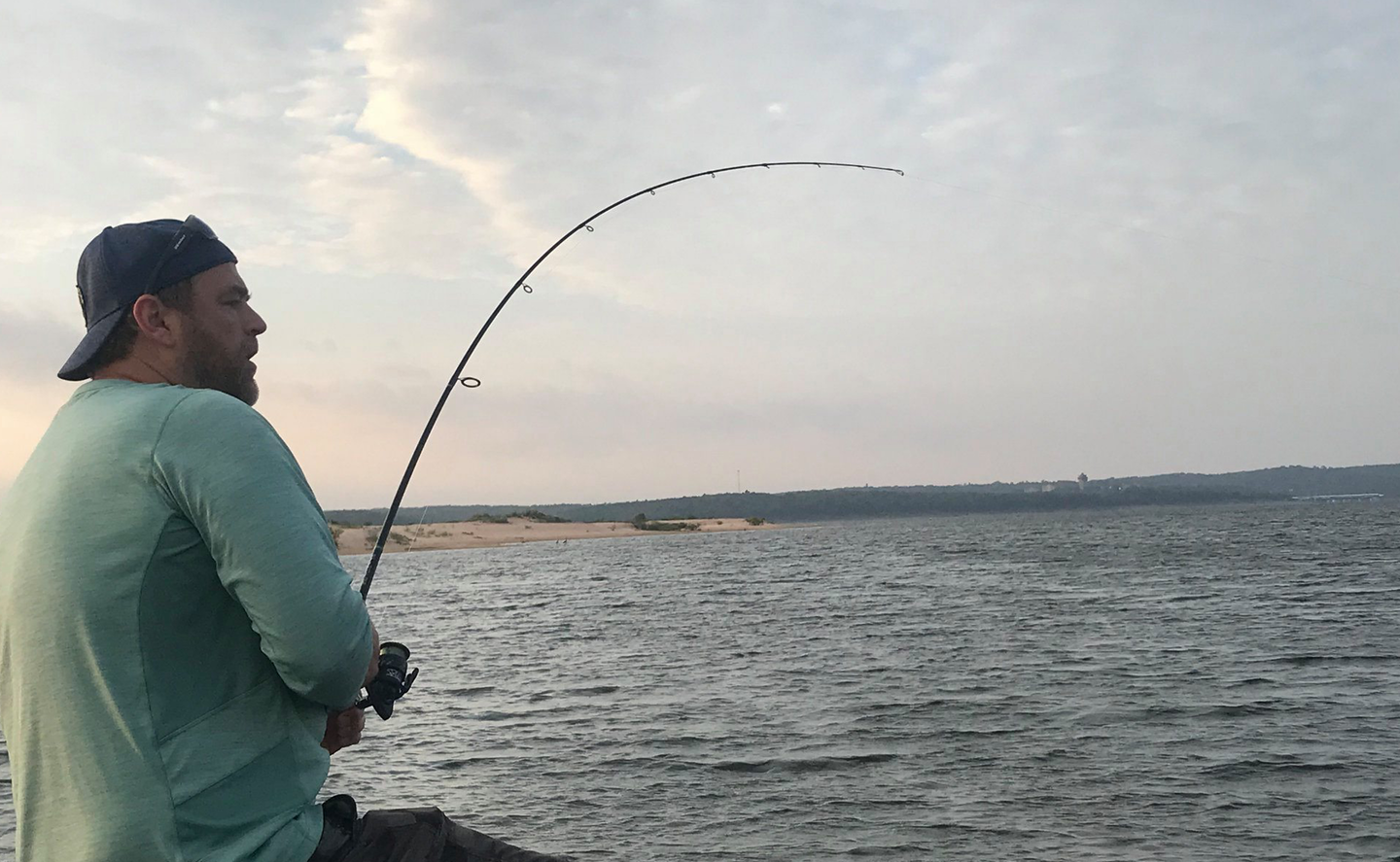We are updating our website and have some great articles that are no longer available online. This one is about Lake Texoma Topwater Striper Fishing! Our good friend and GREAT writer Greg Berlocher have given us permission to use this Lake Texoma topwater article from 2013.
THE SHINY PLUG SAILED THROUGH THE THIN, GRAY light and landed with a loud, awkward splat. After the lure enjoyed a moment of repose, I began my retrieve.
The lure’s concave mouth found purchase in the chop, spitting water with every twitch of the rod tip. As the lure chugged its way back to the boat, a violent explosion shattered the pre-dawn tranquility. The water frothed as a hungry striped bass detonated on the weaving surface plug. Cranking down quickly to remove any slack, I set the hook and was fast to a large fish. The lure’s rear treble hook was pinned solidly in the fish’s jaw, and the angry striper surged for the Oklahoma border. My graphite rod bowed deep into its backbone, and I took note of the rapidly diminishing diameter of the spool as my drag gave up line at an alarming rate. The streaking torpedo eventually slowed and a game of tug-of-war broke out. Continued pressure took its toll on the fish, and eventually 7.5 pounds of striped explosives slid to hand.
Lake Texoma Topwater Fishing for Striped Bass
Lake Texoma is blessed with a naturally spawning population of striped bass, and the lake is one of the top striper fisheries in the United States. The state record, caught by Terry Harber in 1984, tipped the scales at 35.12 pounds. Morone saxatilis is a handsome fish, featuring a streamlined silver body and marked with horizontal stripes from its gills to its tail. With a fondness for open water and a taste for shad, stripers are often compared to white bass, but that isn’t a fair comparison. White bass are small and scrappy, and better suited for light tackle, while stripers are tackle busters, better suited for trout and redfish gear. Best of all, stripers like to feed on the film for much of the year, and their explosive strikes rival those of their largemouth brethren. I was the guest of Striper Express Guide Service, co-owned by old friend Bill Carey. I had finally taken him up on his long-standing offer to show me Texoma’s striper fishery. “You simply won’t believe the outstanding topwater action we have up here,” Carey stated enthusiastically. OK, I was hooked. Before the trip, Carey whetted my appetite explaining that they enjoy topwater action seven months of the year. Surface action cranks up around mid-April depend- ing on the weather, with guaranteed action by May 1st. Later in the summer, action shifts from the shorelines to schooling action in deeper areas of the lake. After the first few cold fronts in the fall and water temperatures moderate, the stripers move back into shallow areas near shorelines. Carey’s son and full partner, Chris, was my guide.
Striper Express-The Best Lake Texoma Fishing Guides
As we motored out of Mill Creek Marina, we talked seasonal strategies. “We pound the shorelines pretty hard during the first part of the year,” Chris explained. “The stripers will be up in the shallow water, just like largemouth bass.” Then around July 1st, the fish move out into deep water and chase bait balls. Incredible schools of fish will drive bait to the surface and boil the water for the first hour to hour and a half of daylight. These schools can be over a mile long and half a mile wide. The sight and sound of all those fish boiling the surface is inconceivable. Our customers will often sit and stare.” “Then in the fall, when things cool off, we head back and fish shallow shorelines again.” The younger Carey suggested that anglers concentrate on three major areas of Texoma for stripers: the dam; Washita Creek, and the Soldiers Creek Marina area. Chris favors large surface plugs, like Chug Bugs and magnum Zara Spooks, but his “go-to” bait is a six-inch Cotton Cordell Pencil Popper. The big plug is equipped with two heavy-duty trebles, and the face is concave, allowing the lure to get a good bite of water every time you twitch it. Chris keeps it simple when it comes to colors: a silver foil belly with a black back at first light, and the same plug with a blue back after the sun comes up. “The wind is your friend on Texoma because you always want a little chop on the surface,” Chris continued. “The chop breaks up the sunlight and allows the stripers to stay up on top longer. When it gets too bright, they head down deep until late afternoon. Chop helps oxygenate the water and also moves the bait around, which in turn, moves the fish around.’ When the sun gets too bright, the stripers sound and head for the comfort of deeper water. “The absolute best conditions are overcast days with good cloud cover and a 10-15 mph wind to kick up a little chop.

Topwater Excitement-Lake Texoma Striper Fishing
The fish stay up on top for hours at a time when you get the right conditions, and you can absolutely slay the fish.” Catches of 50-80 fish are common, but one nice twist to fishing on the film is the size of your catch. “The largest fish of the day are caught on topwaters,” the elder Carey explained. “Largemouth fishermen fall in love with these fish. They have a legitimate chance to catch a double-digit fish anytime they go out.” Texoma was built as a flood control lake, and the water level has held steady for the last several years. While other Texas lakes were as much as 80-feet below pool level, Texoma never dipped more than five-feet below the norm. Because of the economic challenges our nation has faced over the last few years, fishing pressure on Texoma has dropped. Consequently, four-year-old fish that previously weighed 10 pounds, or so, have bulked up and are now 15-pound five-year-olds. Images of the lake’s surface exploding with attacking fish are stored in my cortex. I am already making plans for another trip to Lake Texoma to fish with the Striper Express team (www.striperexpress.com). A double-digit fish is out there waiting for me with my name on it. One word of caution – Never handle explosives, unless they are of the striped variety. For more information please follow Lake Texoma Fishing Guides.
Source: Fish and Game Magazine-Greg Berlocher




0 Comments